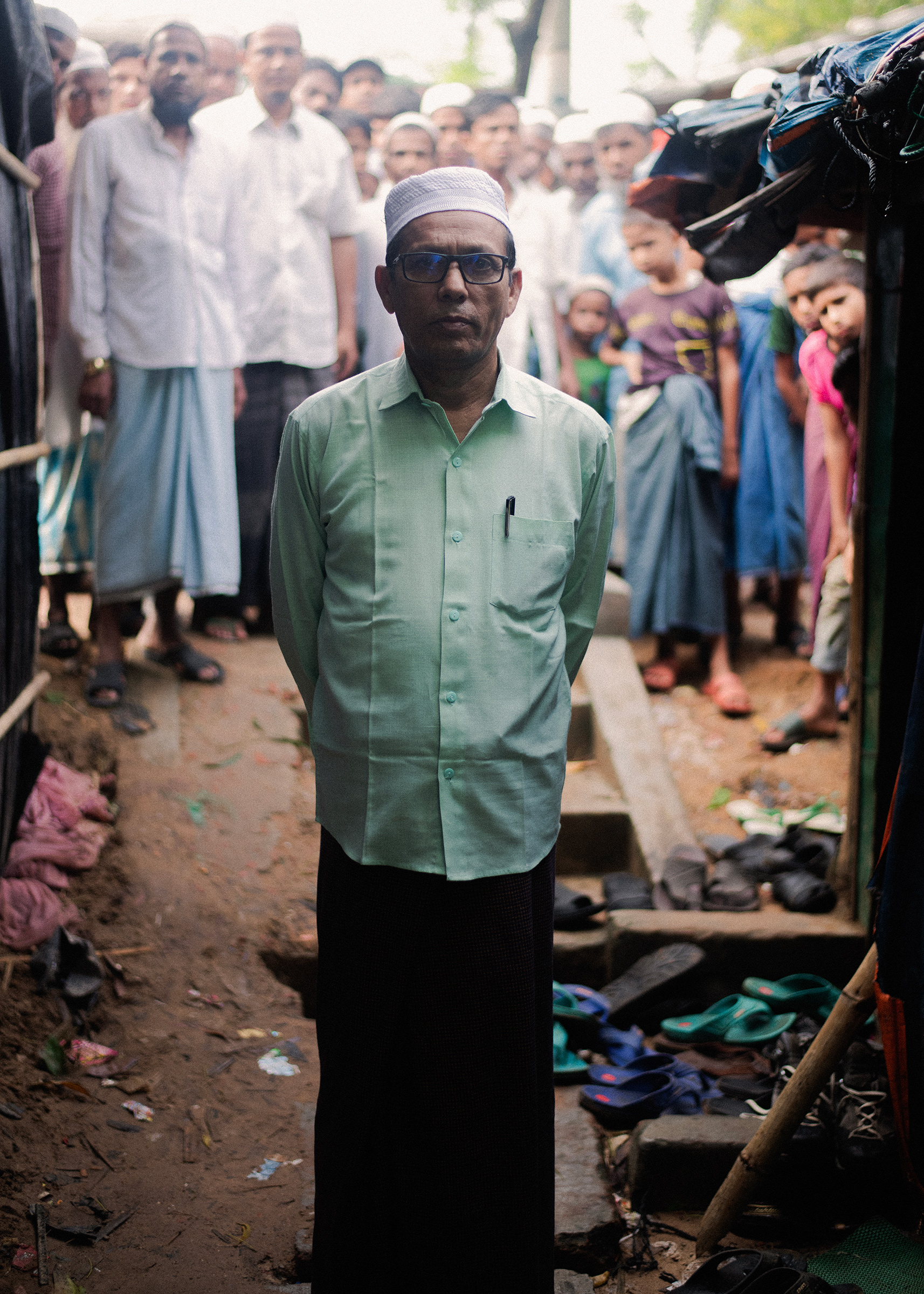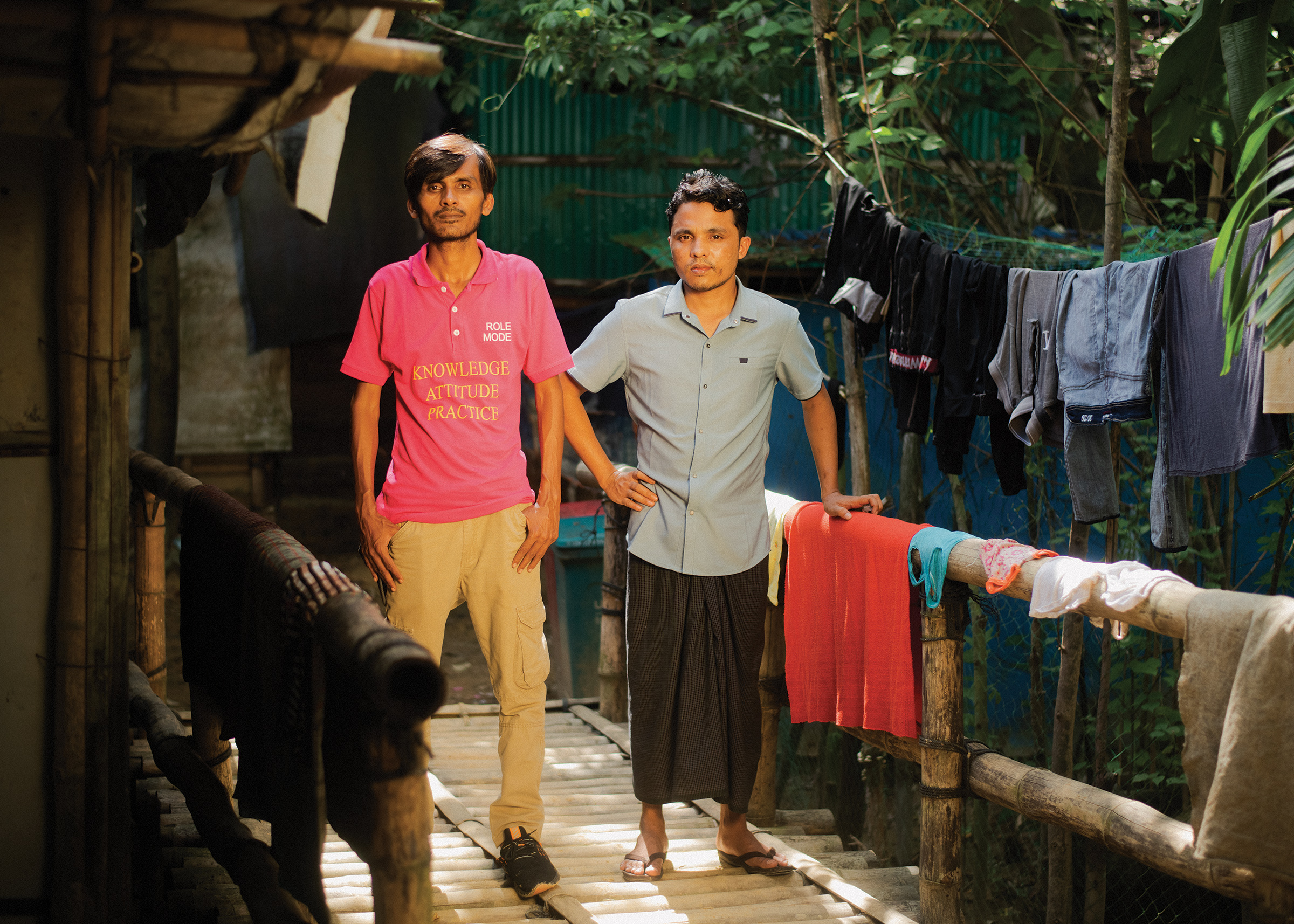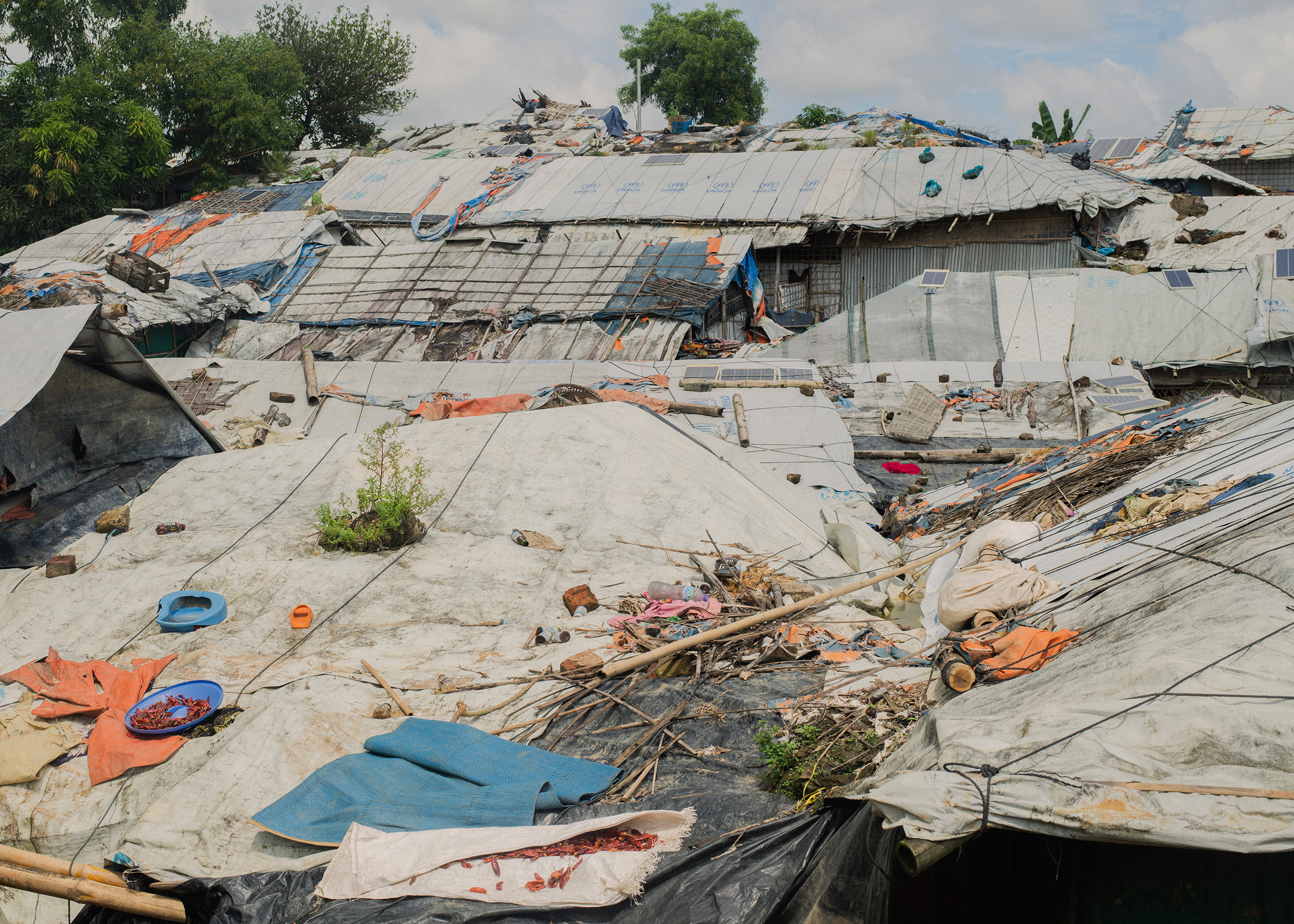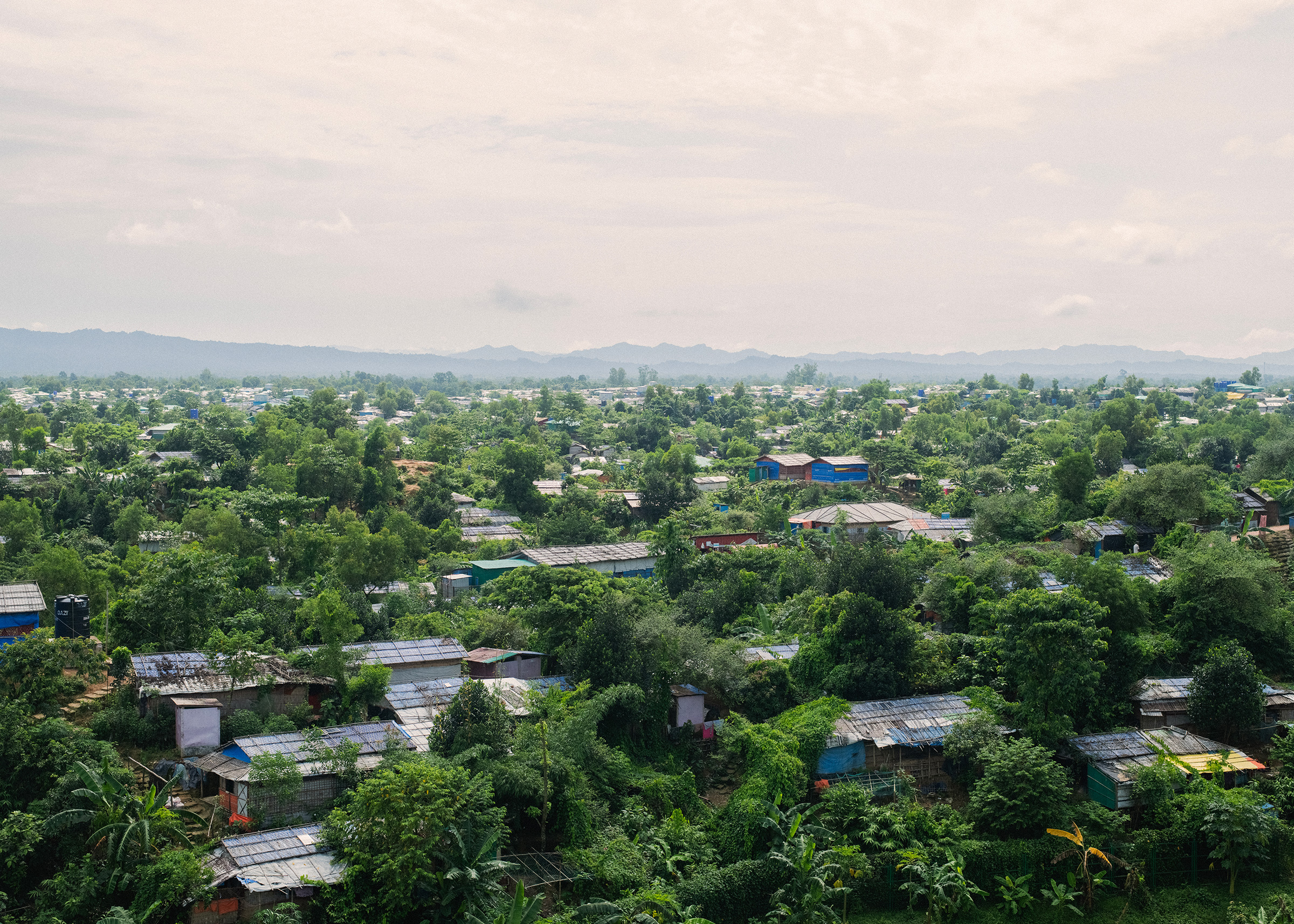Pinned high on the wall of Muhammad Zubair’s bamboo shelter is a photo of his murdered friend. Mohib Ullah was gunned down in Kutupalong refugee camp in southern Bangladesh two years ago in retribution for his community work on behalf of displaced Rohingya Muslims. It was advocacy that led the 48-year-old Mohib Ullah in 2019 to address the U.N. Human Rights Council and even to meet former President Donald Trump at the White House. Not that the gangs that control Kutupalong cared.
Mohib Ullah was a brave voice against spiraling violence and for a dignified return to Myanmar, formerly known as Burma, from where around 740,000 Rohingya fled government pogroms in 2017 that the U.N. deems “a textbook example of ethnic cleansing.” As such, his calls for solidarity threatened the gangs’ lucrative smuggling networks that rely on a cowed, desperate population. Today, even seemingly innocuous social work that might challenge the gangs’ authority is perilous. Of the half-dozen activists TIME spoke to inside Kutupalong, a sprawling slum of some 880,000 beleaguered inhabitants, all have received death threats.
“Ten people sleep here at night for my protection,” Zubair, who took over as chairman of Mohib Ullah’s Arakan Rohingya Society for Peace and Human Rights, tells TIME in his two-room shelter inside Kutupalong. “My own life has been threatened maybe 100 times. But I will continue this activity until I go back to Myanmar or I am killed.”
Zubair knows which fate is more likely. It has been six years since the Rohingya crossed the Naf River to Bangladesh, fleeing violence that claimed an estimated 24,000 lives. The ragtag arrivals brought with them little other than tales of slaughter, arson, and rape. Denied citizenship in Myanmar and in Bangladesh, they are effectively stateless.

Today, Kutupalong is the world’s largest refugee camp—a population larger than San Francisco crammed into an undulating ghetto hewed out of 13 sq. km. of what was once impenetrable woodland. During daylight hours, its deadly underbelly stays hidden. The singsong of nursery rhymes floats above rows of thatch shelters. Children wallop threadbare soccer balls as workmen tend roadside flowerbeds and women in niqab veils barter over samosas and sour plums.
By dusk, however, the mood changes. The guards melt away and bandits stalk the neatly tended allies. Attacks by blade or bullet occur almost nightly. More than 40 Rohingya refugees were killed here in 2022, say human-rights groups, while at least 48 refugees were slain in the first half of this year. The violence is chiefly blamed on the Arakan Rohingya Salvation Army and Rohingya Solidarity Organization, rival insurgents vying for control.
The upsurge in murder—as well as widespread drug dealing and human trafficking—is vexing the Bangladeshi host community and presents a political problem for the Dhaka government as critical elections approach in January. When the refugees first arrived, Bangladesh welcomed them with astonishing compassion. But since then, the world has weathered a pandemic and the return of war in Europe, causing international attention and hope of a resolution to fade in tandem. Now the densely packed country wants the Rohingya gone. “It’s a big burden for Bangladesh,” Prime Minister Sheikh Hasina tells TIME. “They should go back to their old country.”
If only it were that simple. The Rohingya were chased from Myanmar when it was ostensibly a democracy—though today the general directly responsible for their slaughter, Min Aung Hlaing, heads a junta government after staging a Feb. 1, 2021, coup d’état. Democracy icon Aung San Suu Kyi wallows in jail, and the nation of 54 million plunged into a bloody civil war.
Within Myanmar, which is 90% Buddhist, the predominantly Muslim Rohingya are widely despised as foreign interlopers. Despite comprising some 4% of the national population they are not listed among Myanmar’s official tally of 135 ethnic groups. Still, practically all the Rohingya in Kutupalong will on request produce expired ID cards, land deeds, dog-eared photographs, and other papers that they claim prove their Myanmar nationality.

It matters little. The military that has for decades tyrannized Myanmar inculcated a xenophobic, Buddhist-supremacist ideology that demonized the Rohingya, who are typically South Asian in appearance and speak a dialect closely related to Chittagonian. In a nation whose founding myth lies in anti-colonial emancipation, the Rohingya are seen as vestiges of labor migrations forced on Burma when it was administered as part of British India—despite many tracing their family histories back centuries. The violence of 2017 came on the heels of earlier exoduses in 2012, 2000, 1991 and 1978. “In a country where successive post-colonial rulers have warned of the peril of outsiders, these characteristics and histories have combined to drive a popular feeling that Rohingya are foreign, and therefore a threat,” says Francis Wade, author of Myanmar’s Enemy Within: Buddhist Violence and the Making of a Muslim ‘Other’.
From 1982, a new citizenship law recategorized the Rohingya as Bengali aliens, and systematically stripped them of basic rights such as freedom of movement, reproduction, and access to education. As the noose tightened, the impetus to slip away became overwhelming. Rohingya began fleeing the country on rickety fishing boats, hoping to find sanctuary in Muslim-majority nations like Malaysia and Indonesia. Shorif Hussein’s son took a trafficker’s boat to Malaysia in 2012 after he was blocked from attending university in Myanmar. “He now works as a solar engineer in Penang,” says the 54-year-old in Kutupalong.
When the Rohingya first came to Kutupalong, international donors swarmed. Aid workers laid brick roads, dug latrines, and erected medical clinics and food distribution centers. Order was imposed. A unique nine-digit ID number is fastened to the gatepost of every shelter, many of which boast rooftop solar panels. The humanitarian contributions of nations such as Australia, Sweden, and Canada are lionized on outsized billboards peppering the camp. Aid workers filled the business class lounge of every flight to Cox’s Bazar, the nearest city to the camp, where new beachfront hotels sprung up to cater for the influx.
“Financial support for the humanitarian crisis has come almost exclusively from Western countries,” says Peter D. Haas, the U.S. Ambassador to Bangladesh. “So it’s really important that we also expand that donor base.”
Today, however, fresh crises such as the war in Ukraine and Taliban’s return to power in Afghanistan mean dwindling resources in Kutupalong. Less than half the $875 million requirement for funding the camp this year has been met. Infrastructure is crumbling, periodic fires sweep between the crammed shelters, while the monsoon rains bring catastrophic mudslides. Water has been rationed to the extent that preventable diseases are taking hold due to a lack of basic hygiene. At present, some 40% of the refugees suffer from easily treatable scabies.

“Lots of NGO stations have shut down due to reduced funds,” says Dr. Mahmudul Haque, a primary healthcare physician working in the camps for four years. “The population is increasing but supplies are decreasing and quality of service falling too.”
Most crucially, in June the monthly food rations for camp dwellers was cut from $12 to just $8—that’s 27 cents each day, or 9 cents per meal, despite the cost of food soaring here as with many places across the globe. “We are starting to see a lot of patients simply subsisting on rice, salt, and water,” says Arunn Jegan, head of mission for Doctors Without Borders. “It’s a real sense of hopelessness—and it’s getting more fearful because of the violence.”
The pandemic didn’t help matters. To prevent the Rohingya putting down roots, Bangladesh prevents them building permanent homes, receiving a formal education, or legally working. Still, prior to 2020 it was relatively easy for camp dwellers to find casual work as laborers to augment their meager rations. But strict lockdowns to prevent the spread of COVID kept them confined behind barbed-wire fencing and severed this revenue stream. Exploiting desperation, the gangs recruited refugees to smuggle drugs—chiefly “yaba,” a local variety of methamphetamine cut with caffeine—across the porous border. “Only a few people are dealing drugs but it has destroyed the image of our whole community,” says community elder Salim Ullah, 57.
But even as conditions deteriorate, the population of Kutupalong keeps growing. An estimated 40,000-50,000 babies are born into the camp each year, all without access to proper healthcare. “The fact that they’re not getting adequate nutrition during their developmental years means this is a lifetime catastrophe,” says Tom Andrews, a former member of the U.S. Congress from Maine and U.N. Special Rapporteur on the situation of human rights in Myanmar. “The Rohingya have been victimized many times over and they’re being victimized right now by a scandalous response by the international community.”
As food rations shrink and with little in the way of schooling, young people feel immense pressure to join the gangs or flee the camp altogether. This provides fodder for the gangs’ other illicit revenue stream—human trafficking.


According to the U.N., more than 3,500 Rohingya attempted dangerous sea journeys in 2022—the highest number since 2017. At least 348 perished or went missing. Other than death at sea, they also risk capture by the Myanmar authorities. Nur Komal, 23, took a boat heading for Malaysia in the spring but was intercepted by police and has now spent five months in prison in Myanmar’s Kayah state. His elder brother, Anuwar Shah, 25, teaches at an informal school in the camp and says that deteriorating conditions mean that many more young people will attempt the journey in the future. “Without an education, no one can seize their future,” says Shah. “There is no hope.”
Bangladesh is also turning the screws. At first, security in the camp was handled by the nation’s military, which the refugees say maintained order reasonably well. But in July 2020, that job was handed to Bangladesh’s Armed Police Battalion, or APBn, which human-rights groups accuse of systemic abuses, including assault, coercion, and sexual abuse. “Security officers harass women, touching them in private places, taking money from elderly people,” says a female Rohingya activist in the camp who requested anonymity out fear of reprisals. “It is really shameful.”
Women suffer more than most. The Rohingya are traditionally conservative and female family members are rarely allowed to mingle socially after reaching puberty. Throughout the camps, teen boys play and fight in the street while girls are only occasionally glimpsed peeking out from behind the dark curtains of their shelters. “Women are absolutely unseen in all of this,” says Jegan. “I routinely meet women who haven’t even left their housing block for years.”
The specter of harassment and a dearth of female teachers mean few parents dare let girls attend school. Instead, with empty bellies and no means to earn money, child marriage and pregnancies are on the rise. Those who can’t afford the dowries entrust daughters to the hands of traffickers, surrendering to the vain hope that they will find prosperous matches across the waves.
“Before, NGOs ran a lot of activities for young women, like schools and tailoring,” says the female Rohingya activist. “But this has now stopped. Gender-based violence is increasing also. But because of the fighting, their movement is restricted and they can’t even go to hospital.”
Hardly any among the Rohingya refugees has a good word to say about their former lives inside Myanmar—yet all are desperate to return. But huge question marks hang over where and under what conditions.
Following repeated outbreaks of bloodletting in 2012, many Rohingya were forcibly removed from their villages and sequestered in squalid internal displacement camps. Grim as life is in Kutupalong today, Rohingya here cannot countenance swapping one camp in Bangladesh for another controlled by the same soldiers that butchered their kin. They insist on returning only to their original villages. “It’d be better for the international community to bomb us right here than send us back to a camp inside Myanmar,” says refugee Darbash Ali, 61.

Bangladesh has resorted to other extreme tactics. Some 25,000 Rohingya have been relocated to an isolated silt island called Bhashan Char, which only appeared in the Bay of Bengal in 2006. Bangladesh says it has invested up to $300 million to develop infrastructure on the shifting 13,000-acre landmass, including fresh water, electricity, agricultural plots, cyclone shelters, hospitals, mosques, and schools. But some three to five hours from the mainland by boat, and only accessible in good weather, the Rohingya see this as just another jail. “The water is dangerous, there is no proper healthcare nor emergency services,” says father-of-five Kamal Hussein, 53, from Shabazar village in Myanmar’s Maungdaw district. “It is not a safe place.”
China has also attempted to broker a repatriation deal. An initial attempt—coordinated without consultation with the U.N. High Commissioner for Refugees or the Rohingya community—to send back 2,260 Rohingya from 485 families in November 2018 was aborted after the selected refugees went into hiding. Subsequent attempts also failed. Most recently, Beijing brokered fresh talks between Myanmar and Bangladesh in April.
“The Myanmar government nowadays is showing positive signals,” says Sheikh Hasina. “I feel that the U.N. and other organizations that are supporting [the Rohingya] here can also do the same inside Myanmar.”
However, Beijing’s close ties with Myanmar’s military and own record of extrajudicially detaining at least one million Uighur Muslims in the country’s far west makes it far from an honest broker in the eyes of the Rohingya. China—alongside Russia—has repeatedly blocked U.N. statements of concern regarding the escalating humanitarian crisis in Myanmar. “The Chinese government is trying to protect Min Aung Hlaing because they invested a lot of things in Myanmar,” says Rofique Alam, 65, a Rohingya refugee who previously served as a village headman.
Even the return of democracy in Myanmar isn’t a silver bullet for the Rohingya crisis. The 2017 attacks on the Rohingya were perpetrated under the quasi-democratic government led by the disgraced Nobel laureate Suu Kyi, for whom the inevitable compromises of office even included defending the Myanmar military against charges of genocide at the U.N. At the time, Win Myat Aye, social welfare minister in Suu Kyi’s administration, accused Rohingya “terrorists” of torching their own villages. “In the villages where the terrorists can’t enter, there is no burning,” he told the BBC. “When terrorists come in, it burns.”

Now ousted from power by the same military he so staunchly defended, Win Myat Aye, currently Humanitarian Minister for the anti-junta exiled National Unity Government (NUG), has apologized for failing “to bring justice” to the Rohingya. “I feel sorrow when I consider all of this,” he told Voice of America last month. “We apologize for that. It is now evident why we could not administer justice then.”
The NUG has since released statements saying that the Rohingya are integral parts of Myanmar and would be welcomed back once democracy is restored. In July, the NUG appointed a Rohingya, Aung Kyaw Moe, as deputy human rights minister. “We are fighting a common enemy here,” he tells TIME. “To end the dictatorship for once and for all.”
But decades of systemic repression under both military and quasi-democratic governments means mistrust runs deep. Many Rohingya wonder whether the NUG’s newfound sympathy is merely a ploy to win the backing of the international community and would evaporate if they ever did regain control. “Aung Kyaw Moe does not represent the Rohingya community,” says Khin Maung, executive director of the Rohingya Youth Association in the camp. “He wasn’t selected by us.”
In a bid to win favor with Buddhist extremists, Suu Kyi’s National League for Democracy party declined to field any Muslim candidates during the 2015 elections and only put up two in the overturned 2020 ballot. The Rohingya, meanwhile, were disenfranchised from both. “We cannot trust them,” says Nor Along, 67, a Rohingya refugee who previously worked as a civil servant. “It’s just a rumor for us. They are not the official government.”
Proof one way or another will only come with the junta’s defeat and fresh elections—a remote possibility at best. In the meantime, the Rohingya remain trapped between two nations that both shun them, while their proud culture fades away. Young people no longer wear the traditional longyi wrap-around cloth, preferring tees and pants distributed by charities. The Rohingya’s spicy fish and vegetable diet has largely been replaced by blander Bengali staples like potato and daal. “Even my own children sound like Bangladeshi people now,” says Zubair with a shake of the head. “If we stay in the camp for 10 more years then our culture will be forgotten entirely.”
Caught between anger and sorrow, Zubair pauses as he gazes up at the photo of his departed friend. He has been diagnosed with prostate cancer, he reveals, though says he turned down the chance to travel to Canada for treatment. His fate, he insists, like Mohib Ullah before him, lies with his people. “Nobody can jump into a burning building,” he says. “We don’t want to stay here anymore but we need to return home with full rights as citizens. We are human beings just like you.”
More Must-Reads from TIME
- Cybersecurity Experts Are Sounding the Alarm on DOGE
- Meet the 2025 Women of the Year
- The Harsh Truth About Disability Inclusion
- Why Do More Young Adults Have Cancer?
- Colman Domingo Leads With Radical Love
- How to Get Better at Doing Things Alone
- Michelle Zauner Stares Down the Darkness
Write to Charlie Campbell at charlie.campbell@time.com
